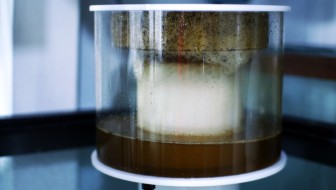A properly sized protein skimmer is key to the success of any marine aquarium system—provided it’s actually doing the job it’s intended to do, that is. Sometimes protein skimmers just keep right on skimming with little or no foam and subsequent liquid skimmate to show for their effort. Why does this happen? Here are six possible reasons:
#1 Poor design
Some makes and models of protein skimmer are just inferior to others by design, so keep the admonishment “caveat emptor” well in mind when making this very important investment. Also, know that you get what you pay for with protein skimmers. Don’t make the mistake of assuming low cost = bargain.
The good news is, all it takes is a little internet research—and perhaps a little chatting back and forth in a few online marine aquarium forums—to find out which makes/models are notoriously bad, which are mediocre, and which have a pretty solid reputation for consistent good performance.
#2 The skimmer is still in its break-in period
Skimmer manufacturers commonly specify that their products require a certain break-in period before they will begin skimming efficiently. This is the time it takes for any trace residual oils or other contaminants from the manufacturing process to dissipate. Prior to the completion of this break-in period, the skimmer may overflow with an excessive amount of microbubbles but produce no real foam or skimmate.
#3 Low bioload
How much protein can a protein skimmer skim if there isn’t any protein to be skimmed? Answer: none. The lower the level of dissolved organic compounds in the water, the lower the level of foam/skimmate production in the skimmer. Therefore, a skimmer in a lightly stocked, judiciously fed aquarium will tend to produce much less foam than one in a heavily stocked, overfed system will. You should also notice a decrease in your skimmer’s foam production following a water change.
#4 The skimmer needs a simple adjustment
In order to produce a nice, thick foam, a protein skimmer must have the right mixture of air bubbles and water in the reaction chamber. Striking that balance may require adjustments to either the water level inside the chamber or the amount of air flowing into the unit. Sometimes it can take a while and numerous tweaks to get the skimmer dialed in just right, but patience will eventually pay off.
#5 Components are clogged
A very common occurrence with protein skimmers is that certain components—air-intake hoses, valves, etc.—get clogged with calcium carbonate or salt buildup. When this happens, you’ll usually notice a significant reduction in the amount of bubbles inside the chamber and a subsequent drop-off in foam production. The fix is easy, though—just disassemble the skimmer and soak the components in white vinegar for a while. Give them a good rinse, reassemble the skimmer, and you’re back in business!
#6 The neck is dirty
Over time, the inside neck of a protein skimmer tends to develop a slimy coating of brown gunk. This buildup interferes with foam production—essentially the foam collapses in the neck and adds to the gunk layer instead of rising up into the collection cup and collapsing there where it can be emptied and eliminated. To prevent this buildup, you’ll need to wipe the neck of the protein skimmer with a clean paper towel or cloth on a regular basis.




If you had medicine in the tank the Skimmer will go MAD
Ah, yes! Great point, Neil. Thanks!
Also if the salinity is too low it won’t foam well
Good point, Ron! Thanks!
Another reason is oily food. If you put any type of oil in the water the skimmer will stop as it affects the water surface tension.
Good addition as always, Paul!